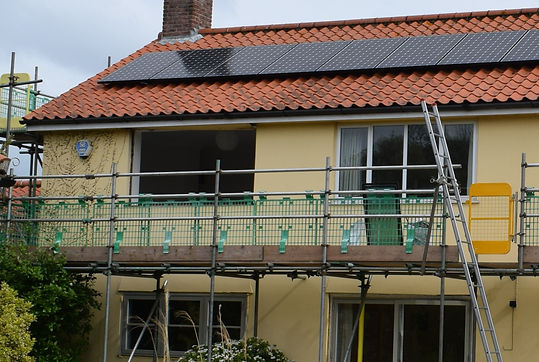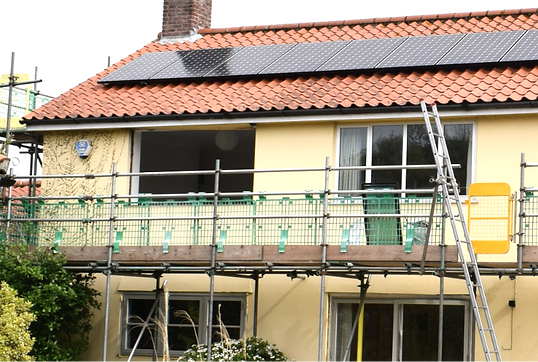

The Refurb Page
You don't have to do a big refurb to get to Net Zero, and house fabric measures like windows and wall insulation are unlikely to be cost effective on energy savings alone. But if you plan a refurb anyway, take the opportunity to max your home's thermal performance, it may cost very little extra.
Before we start:
We want to ensure your refurb or retrofit builds in all the cost-effective features you need to smooth your way to Net Zero. But we want to start with one important message. It's not one you'll hear everywhere for sure. But...
Don't do a big, dusty, five figure house refurb just for Net Zero or energy reasons!
At least, not if you want it to pay back in less than 10 years. It probably won't. Yes, fabric measures saved us 30% of our energy bill or around 300 pa at that stage. But the total capital cost of the measures that achieved that was (gulp) nearly £50k, mainly comprising new windows and external render. 166 year payback! Not worth it, if you're on a budget. Bolt-on measures like solar were easier and much more immediately cost-effective.
The reason we did that refurb, of course, was the that house was knackered and needed it. We had gaping, non-fitting blown windows, and vast cracks in the render, and we got the place cheaply for that reason. We spent the money saved on the refurb, and are reasonably confident that this would add to the house value and comfort accordingly. In the process, we were able to ensure that the windows and new, insulated render would deliver those energy savings, but we would never have done it for energy reasons alone. In fact the energy related investment only amounted to about £3000 of that, being the extra cost of triple vs double glazed windows.
So do energy work in line with your normal maintenance and refurb plans.
That way you do the work you were going to do anyway, but the net zero way. It will often cost little extra.
This approach can of course delay your progress, but that's better than unsupportable costs. (this of course applies to the whole economy too, not just individual homes!).
Refurb tips
First, sketch out your plan regardless of net zero - then tweak it to fit. This applies not just to what you do, but when you do it. Then, see these tips as to how to optimise your various activities for a net zero home.
Extension
One of the biggest in money terms, but also biggest in net zero opportunity. You're essentially doing part of a new build, with most of the design freedom that implies. Yes, you need it to fit with the existing house. But under the (matching) skin you can use the most energy efficient materials available for floor, walls and roof. Even if you just doubled your wall cavity size, you would nearly halve your wall energy loss, for the cost of just one extra one layer of insulation - you were paying for the inner and outer skin anyway. So:
-
Architect: try to choose one that takes energy efficient design seriously. This is not actually hard, this is a major topic in house design.
-
Try to make the final building as compact as possible, with the minimum external area. This is the most energy efficient layout. The more a house has skinny wings sticking out, the more heat it will lose. You have probably been in a cold, single-storey kitchen extension which loses heat on every side.
-
Look for opportunities for passive solar design. This means large south facing windows. They enable you to heat the house directly on sunny winter days (which are surprisingly common). You may need to make provision for cooling as well, with blinds or curtains.
-
Maximise wall, roof and floor insulation (don't forget the floor). Don't let builders or architects put you off because they just want to do what they always do. Apart from just added insulation, consider alternative design techniques like timber frame or SIPS (structural insulated panel system).
-
Either leave your heat pump till after the extension, or ensure you have the design ready and can do the heat loss calculation for the new building, not just the old.
-
Consider how the new roof may work for solar PV. The roof should preferably be pitched at about 30o, as close to south as possible. A flat roof is not quite as good for solar. Obviously, install your PV when you build the extension and the scaffolding is still up. Some panel designs are integrated into the roof and will save on roof tiles.
-
Windows: you may well be using new in the original house as well the extension. If not try not to just match the old windows however poor they may be thermally. Look for a design with low heat loss (Uw <1), which adequately matches the old windows.
-
Install under floor heating (UFH), as this is easy at the build stage, more comfortable and convenient than radiators, and works especially well with heat pumps. You can easily combine with radiators in teh old part of the house. (note that in highly insulated new builds or extensions, radiators upstairs are often unnecessary!).
Loft extension
-
When you extend into an existing loft you lose the easiest, cheapest insulation option - rockwool inm the loft. You will need to replace it with "room in roof" insulation. This often has to fit into a tighter space, so use higher spec insulation like PIR board to get the maximum insulation in minimum space.
-
Try not to lose a good solar PV location. Install your PV when you have the scaffolding up, this will reduce the price.
Render, cladding or repointing
-
If you are replacing render, this is a great opportunity to add External Wall Insulation (EWI). Because in the UK re-rendering attracts only 5% VAT if insulation is applied at the same time, this can cancel out any additional cost. We did this, and had NO extra cost from insulating almost all the outside walls of the house.
-
Repointing brick: what will this cost? Is there any advantage to re-rendering or cladding instead, allowing you to add EWI as above?
New windows
-
While appearance is critical, look for companies which offer high (thermal) performance windows for a similar price to basic windows, and much cheaper than certain high profile names! Examples include Velfac, Rationel and Green Building Store. You're looking for a window u-value of <1. Remember that triple glazing has soundproofing advantages too. Do windows before re-rendering, so the render can overlap the windows.
Garden room
-
A small room in the garden does not keep warm easily. They can easily be very cold and expensive to heat, and end up damp and underused. Prefab designs can seem tempting, but could you use an existing space in your house instead, or an extension?
-
So the most important feature of any garden room you buy or have built, is that it has great insulation - just as good as a house - in the walls, floor and roof. Look for a U-value for each component <0.25W/m2K, and walk away from anything that doesn't have full U-value data.
-
Heating options include extending the central heating from your house, if the distance is small, or using an air to air heat pump.
Kitchens and bathrooms, or any other extensively remodelled room.
-
Take advantage of everything being ripped out to add internal wall insulation on one or more outside walls (maybe unnecessary if you are doing EWI too). Note that you will lose 100mm or so off the room dimension.
-
Add insulation in hidden spaces behind baths and units if against an outside wall. This can just be cheap rockwool stuffed into the space. Keeps your bathwater hot longer too!
-
Ensure that any new kitchen appliances you buy are the top level of energy efficency, normally A+++. They will not always be the cheapest, but will display how much they cost to use per year. Work out the Total Cost of Ownership (TCO) and you'll often find the "cheap" one is not really.
-
Try to avoid energy wasting items like boiling water taps, power showers or enormous US-style fridges. We all have our weaknesses for these things but they are wasteful. Instead of a boiling water tap, just put a thermos next to the kettle fill it up whenever you boil the kettle and it works just as well!
-
A shower should be fed from your hot water tank which should be heated by a heat pump. This will be a quarter of the cost of a power shower. If you already have a power shower, prioritise getting rid of it when you do up the bathroom.
-
If you're worried about water pressure, you may have a vented hot water system relying on gravity and a hot water tank in the roof. When you put in the heat pump, this is normally replaced by an unvented system under mains pressure, which will improve the pressure of your shower.
Conservatory
-
Don't put heating in a conservatory! It is a glass room, heat will flee from it, no matter where you get it from. A conservatory can help with passive solar heating of a house, but if it does it may overheat in summer. Remember the original meaning of the word, which is to conserve senstive plants - it's a greenhouse attached to a house.
Garage
-
If building or altering a garage, there is an advantage to a pitched roof that enables more solar PV to be be fitted. We were able to add 50% more solar when we did this.
Fireplace / wood burner
-
Be aware that wood burners cause significant air pollution, and the wood they burn is probably not carbon neutral. Especially, do not install or use a wood burner in a major city. While this is legal at the moment, they have a disastrous impact on urban air quality. A wood burner is best as an occasional luxury and as backup, rather than for daily use. Unless you have your own forest, wood fired heat will often be more expensive than heat pump or gas fired heat.
-
Don't consider an open fire, they cause enormous indoor pollution and waste lots of heat.
-
If you have an an unused fireplace, it can be a major source of draughts. Block it with a "cushion" sold for the purpose or have it professionally blocked.
Decoration
-
You wouldn't think that just painting a room could be a path to net zero would you? Well, you're mostly right, but if a room is in a state to the extent it needs replastering, consider putting in internal wall insulation for any outside walls. (this will need replastering over the top).